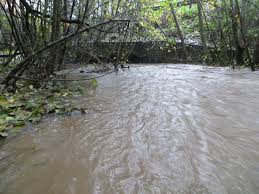
My eight-year-old granddaughter and I stopped by Nathanson Creek at the Second Street East bridge yesterday to catch a look after the heavy rains. The water was rushing quickly, having filled the channel halfway up the height of the tunnel under the road.
“Papa, why is the water brown?” she asked me. It was, in its way, a powerful question, and I thought a moment before answering her. “Well,” I began, “that’s a good question. And the simple answer is that the water is brown because erosion causes the topsoil, exposed dirt, to run off from the rain and be carried by the rushing water into the creek.” “Oh,” she said.
There is so much more I could have said, and as she grows older I will say more to her. The deeper story about the muddied water in the creek includes the interaction of culture, economy, farming practices, urban infrastructure and our love/hate relationship with the land.
The natural condition of running surface water is clarity. Creeks incorporate natural filtration systems that remove particulates; undisturbed gravel beds, riparian plants and weeds, surface irregularities, curves, and even wildlife all contribute to keeping creek water clear. In other words, the absence of human interference is critically important to the reduction of turbidity, or as my granddaughter called it, brown water. The real cause of brown water is people.
The loss of topsoil is a tremendous problem; not only does it impoverish the land used for farming, but it ends up as massive silt deposits in larger bodies of water, such as San Francisco Bay. At this point in time, impoverishment of the land used for farming is both the cause and the result of our ways of agriculture; it is the cause due our greed and the result of it.
In this valley, our major farms are called vineyards, the place where grapes are grown to make wine. We all know that grapes grown in Sonoma Valley are some of the finest in the world, but often it’s forgotten that the primary reason is because our valley soil is some of the finest in the world. It is that fact, the superb quality of our soil, that has over time produced a wide variety of farm products, and it remains the reason why vineyards are successful.
In modern society, success means money and prestige, and the lure of both has fueled a boom in vineyards. Unlike farmers of the past, today’s wine-oriented agriculture has steadily moved to the hillsides, but proper farming practices such as small plots, hedgerows, crop rotation and genetic diversity have fallen by the wayside. Instead, hillside vineyards are permanent, exposed, prime examples of modern monoculture, perfect candidates for erosion, run-off and the loss of topsoil.
To replace lost, natural fertility of topsoil, farmers use man-made fertilizers. To replace the naturally balanced ecosystem of plants and insects, they are labeled “weeds and pests” and herbicides and pesticides are used to destroy them. These poisons and fertilizers join the lost topsoil in run-off, contribute to the turbidity of water and promote the growth of algae in the bay and other larger bodies of water.
Underlying all this, of course, is greed, the hallmark of Agribusiness. Agribusiness is the use of industrial methods and psychology, and has largely replaced “farming.” Accordingly, the brown water in the creek is greed made visible.
Irresponsible land management can certainly lead to topsoil loss, but human activity is not a necessary precursor to stream siltation and erosion. The Colorado River carved the Grand Canyon millions of years before greedy humans set foot on this continent.
That’s true, but I think it’s a stretch to compare a creek in Sonoma with the Colorado River.
An extreme example to make a point. Silt being carried by a creek in Sonoma after heavy rainfall is not necessarily the result of bad people.
Let us not overlook road shoulders as major contributors. My belief is that ranks higher than most. We do enjoy our roads.
Just call them careless people.